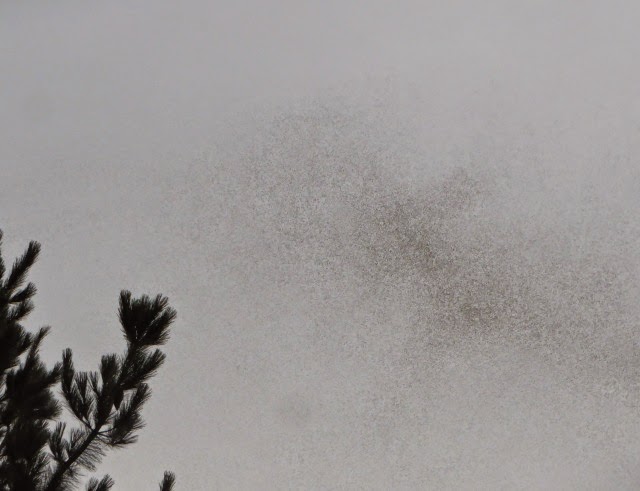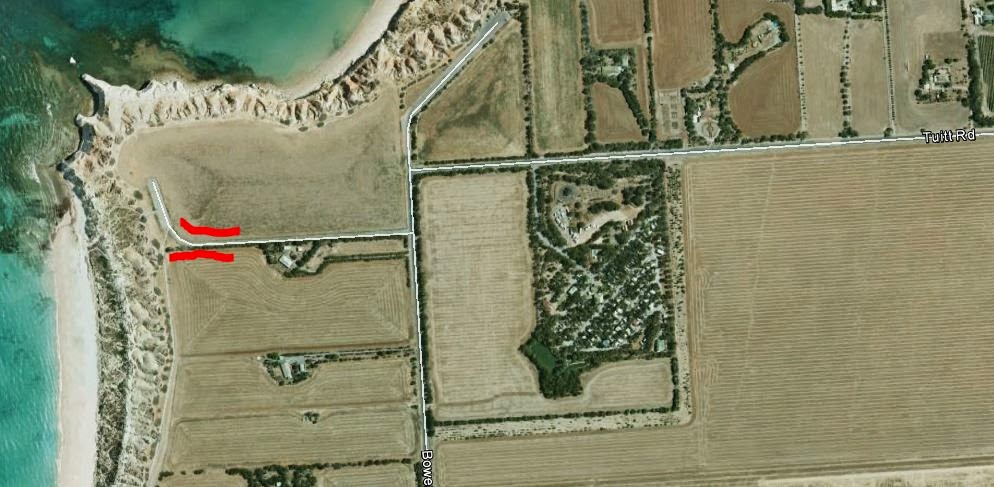Are Dusky Woodswallows migrants?
This question has been raised recently on the chatline. The information available from the Garden Bird Survey (GBS) is too much to fit in my Gang-Gang (see http://canberrabirds.org.au/index.htm) articles, but not complete enough for a CBN article. So I have stuck it here.
HANZAB (v1A p19) defines ‘migratory’ as “all or most individuals moving between breeding and non-breeding ranges”. Wikipedia has a few more words under 'Bird migration":
Reading the HANZAB species account (v7A p456) shows that the debate about whether this species is a migrant, and which subset of migration patterns apply to it, has been ongoing since at least 1920!
Seasonality of observations

Looking at aggregate data for the whole 27 years of GBS data shows a clear peak in the number of birds observed in March-April May and a lesser peak in September. There are very few records of the species in the GBS for June and July in particular.

Examining the number of birds recorded in each year for Autumn ( March to May) and Winter (June to August) gives a somewhat more interesting picture. Note that in this graph the horizontal axis is for calendar years since Winter goes across the GBS year boundary.
March to May) and Winter (June to August) gives a somewhat more interesting picture. Note that in this graph the horizontal axis is for calendar years since Winter goes across the GBS year boundary.
At an even more detailed level the pattern within the Winter months changes somewhat. For 2003 - 2005 there are some birds in all three months, showing full overwintering. For 2006 - 2007 June and July are empty (except for 3 birds in June '06) while each August still has a small number of birds. While all the earlier records of Wintering birds are in August they are not as consistently present as in the last few years.
Half of the Winter observations of Dusky Woodswallows in recent years come from Curtin and 7 of the remaining 8 come from the Northside of Canberra (interestingly, mainly sites close to grazing or equestrian areas).
Overall abundance of birds
 The graph to the left shows the value of A (ie the average number of birds of this species seen per active week per site) for all 27 completed years of the GBS. While the value of R2 is not high enough to indicate a significant trend over time, if the extreme value for year 24 is replaced by the average of years 23 and 25 the overall shape of the graph remains the same while the value of R2 rises to 0.70, much closer to significance.
The graph to the left shows the value of A (ie the average number of birds of this species seen per active week per site) for all 27 completed years of the GBS. While the value of R2 is not high enough to indicate a significant trend over time, if the extreme value for year 24 is replaced by the average of years 23 and 25 the overall shape of the graph remains the same while the value of R2 rises to 0.70, much closer to significance.
Breeding records
It is also possibly interesting that in GBS year 24 (which contains the breeding period following the 2003 bushfires) the number of breeding observations was 10. This contrast with most years not recording the species breeding at all, or at most 1 or 2 breeding records. This supports a comment made to me that the increased number of GBS observations shown in the graphs reflect a change in behaviour following the fires. Now that the mountains are recovering from the fires the birds are returning to a more traditional pattern.
Conclusion
My conclusion is that, in this area, GBS data suggests the species certainly satisfies the definitions of a migrant given in HANZAB and Wikipedia.
There seems to have been a major 'shock' to the seasonality of the bird's presence in the more urbanised part of the ACT following the 2003 bushfires. It is possible that matters are returning to the previous situation, possibly with the species arriving earlier than in the past.
HANZAB (v1A p19) defines ‘migratory’ as “all or most individuals moving between breeding and non-breeding ranges”. Wikipedia has a few more words under 'Bird migration":
"Bird migration refers to the regular seasonal journeys undertaken by many species of birds. Bird movements include those made in response to changes in food availability, habitat or weather. These however are usually irregular or in only one direction and are termed variously as nomadism, invasions, dispersal or irruptions. Migration is marked by its annual seasonality. (emphasis added MB) In contrast, birds that are non-migratory are known as resident birds. "
Reading the HANZAB species account (v7A p456) shows that the debate about whether this species is a migrant, and which subset of migration patterns apply to it, has been ongoing since at least 1920!
Seasonality of observations

Looking at aggregate data for the whole 27 years of GBS data shows a clear peak in the number of birds observed in March-April May and a lesser peak in September. There are very few records of the species in the GBS for June and July in particular.


Examining the number of birds recorded in each year for Autumn (
 March to May) and Winter (June to August) gives a somewhat more interesting picture. Note that in this graph the horizontal axis is for calendar years since Winter goes across the GBS year boundary.
March to May) and Winter (June to August) gives a somewhat more interesting picture. Note that in this graph the horizontal axis is for calendar years since Winter goes across the GBS year boundary.At an even more detailed level the pattern within the Winter months changes somewhat. For 2003 - 2005 there are some birds in all three months, showing full overwintering. For 2006 - 2007 June and July are empty (except for 3 birds in June '06) while each August still has a small number of birds. While all the earlier records of Wintering birds are in August they are not as consistently present as in the last few years.
Half of the Winter observations of Dusky Woodswallows in recent years come from Curtin and 7 of the remaining 8 come from the Northside of Canberra (interestingly, mainly sites close to grazing or equestrian areas).
Overall abundance of birds
 The graph to the left shows the value of A (ie the average number of birds of this species seen per active week per site) for all 27 completed years of the GBS. While the value of R2 is not high enough to indicate a significant trend over time, if the extreme value for year 24 is replaced by the average of years 23 and 25 the overall shape of the graph remains the same while the value of R2 rises to 0.70, much closer to significance.
The graph to the left shows the value of A (ie the average number of birds of this species seen per active week per site) for all 27 completed years of the GBS. While the value of R2 is not high enough to indicate a significant trend over time, if the extreme value for year 24 is replaced by the average of years 23 and 25 the overall shape of the graph remains the same while the value of R2 rises to 0.70, much closer to significance.Breeding records
It is also possibly interesting that in GBS year 24 (which contains the breeding period following the 2003 bushfires) the number of breeding observations was 10. This contrast with most years not recording the species breeding at all, or at most 1 or 2 breeding records. This supports a comment made to me that the increased number of GBS observations shown in the graphs reflect a change in behaviour following the fires. Now that the mountains are recovering from the fires the birds are returning to a more traditional pattern.
Conclusion
My conclusion is that, in this area, GBS data suggests the species certainly satisfies the definitions of a migrant given in HANZAB and Wikipedia.
There seems to have been a major 'shock' to the seasonality of the bird's presence in the more urbanised part of the ACT following the 2003 bushfires. It is possible that matters are returning to the previous situation, possibly with the species arriving earlier than in the past.



Comments